

|
Japanese External Reverse Porro Prism Binoculars. Binoculars MUSEUM |
|
Mark Ohno |
|
How to Repair the Textured Paint of Old Binoculars. Wie Man die Strukturlack der Älteren Fernglas Reparieren. Comment Faire pour Réparer la Peinture Texturée des Anciennes Jumelles. Как отремонтировать текстурированной краской старый бинокль. Hur Man Reparerar det Strukturfärg för Gamla Kikare. Cómo Reparar la Pintura con Textura de Viejos Prismáticos. Come Riparare la Vernice Strutturata dei Vecchi Binocoli. |
|
It is usually difficult to touch up old miniature binoculars without your efforts being rather obvious. But there can be exceptions, as shown below. |

|
Nice pair of pre war Race 6x15 binoculars with case… But... |

|
... a previous owner scratched their name into the paint of a prism cover, in a particularly crude and ugly way. But because the paint is crinkle paint (heavily textured), it is quite practical to make good remedial repairs. |


|
For years I recommended Krylon ® “Wrinkle Finish” paint for binoculars and their paints in general. Lately I’ve had problems with various of their paints perhaps due to formula changes and did not have a good experience of them honoring the satisfaction warranty on the cans. Rustoleum ®now makes a wrinkle finish paint and I have some but haven’t tested it as much. The wrinkle finish typically appears when the paint is almost dry. As dry time is a bit slow, I prefer to force dry the work with a heat gun or hair dryer to the point that the paint flashes and texture appears. It only takes a few minutes, using that forced drying technique. Be careful not to blow the paint around. |
|
The paint must be applied in a rather thick layer in order to “wrinkle” properly as it dries. In this case I chose to paint the entire panel where the owners name had been scratched, and applied the paint by brush rather than masking and spraying. And I also touched up the wear on the edges of all the prism covers as shown in the photo. |

|
This is the final result. There is no sign of the name, and it is not obvious that anything has been done, so I am quite pleased with the result. |

|
After repair. Nach der reparatur. Aprčs réparation. Efter reparation. Depués de la reparación. |
|
Before repair. Vor der reparatur. Avant réparation. Före reparation. Antes de la reparación. |
|
How to Improve the Appearance of Old Cases for Binoculars . Wie Man der Darstellung von Schutzhüllen für Ferngläser Verbessern. Comment Améliorer L'apparence de cas Anciens pour Jumelles. Hur Man Kan Förbättra Utseendet Pĺ Gamla Ärenden för Kikare.Cómo Mejorar la Apariencia de Viejo Casos para Prismáticos. Come Migliorare L’aspetto di Vecchie Casse per Binocoli. |
|
It is easy for anyone to improve the appearance of worn or distressed binoculars cases with a bit of shoe polish. For brown cases I prefer to use dark tan polish, so as not to darken the color. |
|
Before repair. Vor der reparatur. Avant réparation. Före reparation. Antes de la reparación. |

|
After repair. Nach der reparatur. Aprčs réparation. Efter reparation. Depués de la reparación. |


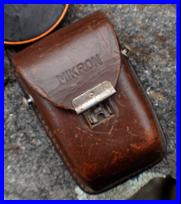


|
Before repair. Vor der reparatur. Avant réparation. Före reparation. Antes de la reparación. |
|
After repair. Nach der reparatur. Aprčs réparation. Efter reparation. Depués de la reparación. |
|
Note: there are paint compatibility issues between enamel and lacquer. Enamel can usually be successfully applied over air dried and baked lacquer. But lacquer usually cannot be successfully applied over enamels, as the aggressive lacquer solvent will often attack the previous enamel coat and cause it to peel or “alligator”, especially around chipped areas. A second lacquer coat over a previous lacquer coat is OK, and an enamel coat over a previous enamel coat is OK, and enamel over a previous lacquer coat is usually OK. I think most Japanese binoculars were originally painted with lacquer. |
|
How to Use Wax and Polish to Improve the Appearance of Old Binoculars . Wie Sie Wachsen und Polieren Verwenden, un das Aussehn der Ferngläser Verbessern. Comment Utiliser la Cire et Polonais pour Améliorer l’apparence des Jumelles. Her man Använder Vax och Polish för Förbättra Utseendet pĺ Kikare. Cómo utilizar Cera y Polaco para Mejorar la Apariencia de los Prismáticos. Come Usae la Cera e il Polacco per Migliorare L’aspetto dei Vecchi Binocoli. |
|
I suspect that a lot of older binoculars used a lacquer paint finish. Japan has a long tradition of using lacquer for painted finishes. There are various lacquer formulations, and with the invention of nitrocellulose lacquer in 1921 (cellulose resin plus high volatility fast drying solvents) it became popular because of the quick dry time. Lacquer finishes can get cloudy with age or prolonged exposure to a humid environment. While I encounter a dull cloudy finish on full size binoculars more often than on miniature ones, it is good to know how easy it is to get a great improvement with minor effort using automotive polish or wax on these finishes. I like carnauba wax plus elbow grease. |

|
Before repair. Vor der reparatur. Avant réparation. Före reparation. Antes de la reparación. |
|
Typical cloudy dingy finish. No wear, but doesn’t present well. And not dirty:these have already been cleaned, which really did nothing to improve the appearance. |
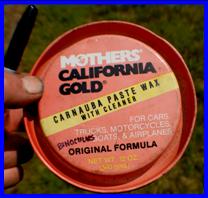
|
+ |
|
= |
|
After repair. Nach der reparatur. Aprčs réparation. Efter reparation. Depués de la reparación. |

|
After a few minutes of polishing. Small effort. Big improvement. |
|
Wax and some rubbing... |


|
Sad Birks case from a London Hospice shop |
|
Same revitalized Birks case from a London Hospice shop after 5 minutes of polishing. |
|
Uncooperative Center Focus Mechanism. Repair Tip . Unkooperativer Fokus Mechanismus. Reparatur Tipp. Centre Non Coopératif Mécanisme de Mise au Point. Réparation Astuce. Миниатюрные бинокль ремонт предложение. 小型双眼鏡修理提案 . Icke Samarbetsvilliga Fokus. Reparera Tips. Mecanismo de Enfoque Central que no es operativa. Reparación Punta. Meccanismo di Focalizzazione del Centro non Cooperativo. Suggerimento per la Riparazione. |
|
Seized central focus mechanisms on miniature binoculars can often be made operative with penetrating lube and a bit of patience moving the focus wheel back and forth. But the problem can also be hardened optical grease within the mechanism, and there are times when lube and force will not work. In this case heat from a pencil torch will normally work on ocular focus models, given generous effort and patience. |
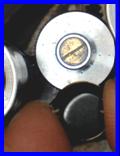
|
Unscrew the end cap for the center focus wheel. |

|
Heat the center focus center to free the focus wheel, and progressively heat and move the wheel to free it up. |

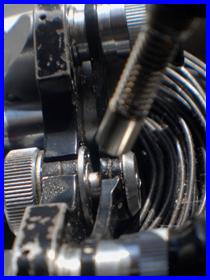
|
Heat the center post of the ocular mechanism in 2 places as shown and move the focus wheel to free it up. |
|
Once the focus mechanism is moving apply lube to the points shown and continue to work the focus wheel until it works well. |

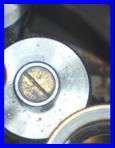




|
Collimation: Modern Chinese Miniature Binoculars . Kollimation Moderne Chinesische Zwergferngläser. Collimation: Modern Jumelles Miniatures Chinoises. コリメーション:現代中国ミニチュア双眼鏡 . Коллимация: Современные китайские Миниатюрные бинокли. Η ευθυγράμμιση: Σύγχρονη κινεζική Μινιατούρα Κιάλια. Kollimering: Modern kinesiska Miniatyr Kikare. Colimación: Modern Prismáticos Miniatura Chinas. Collimazone: Binocoli Cinesi Moderni. |

|
Current Chinese pattern miniature binoculars are easily recognized by distinctive oversize rubber eyepieces that flip inward for eyeglass wearers. Some examples are Barska Blue Line 10x20 binoculars, Cstar Optics 10x20 binoculars, Sharper Image 10x20 binoculars, Stanley London 8x20 binoculars, Minox 10x20 and 6x20 binoculars, Netjet 10x20 binoculars, and Young Generation 10x20 binoculars. |
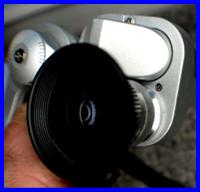
|
An ocular side screw adjusts the objective side prism. |

|
An objective side screw adjusts the ocular side prism. |

|
When rotating the screws on the objective side of the binoculars, the bell of the objective barrel interferes with your screw driver. But the objective barrels normally unscrew quite easily by hand. |
|
The older Japanese binoculars with prism adjusting screws typically adjust their prisms using two horizontal opposing screws to slide the prisms horizontally along their longer plane |


|
Current and recent Chinese binoculars with prism adjusting screws typically adjust their prisms using a single vertical screw to lift one side of the prism and tilt it against a spring above it in the prism cover. |

|
Water Damaged Binoculars . Wasser Beschädigt Ferngläser. Jumelles Endommagés par L'eau. Повреждение водой Бинокль. 水破損双眼鏡 . Vatten Skadade Kikare. Prismáticos Dańados Agua. Binocoli Danneggiati Dell’acqua. |



|
Binoculars don’t like being dunked in water. And being dunked in salt (sea) water leads to a lot of aggressive damage. The usual result is pictured above: these York binoculars had taken a dunk in seawater in the past, and the screws and steel parts spread rust everywhere. They were sold with the dishonest description of “some signs of cosmetic wear, but fully operational and functions as intended”. But original operation did not really intend peering through cloudy mud brown optics. So these are perfect to show some techniques of remediation. |

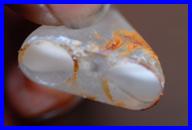
|
Prism before cleaning. |
|
Mechanical cleaning attempt. Prism is being mechanically cleaned with polishing compound and a buffing wheel on rotary tool. The deposited stains are uncooperative. |
|
Mechanical cleaning failed to remove all deposits, and left a haze. My conclusion is that mechanical methods by themselves are unlikely to successfully remediate rust water staining. |
|
Oxalic acid is a good rust cleaner, and is available in diluted commercial solutions such as “Bar Keepers Friend®” |





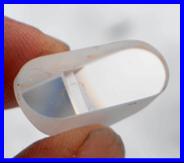
|
Prism after mechanical and chemical cleaning with oxalic acid. Faint marks are actually on the reverse surfaces. This is functional. |
|
Housing before cleaning. Both frame and lens are stained. |

|
Housing after chemical cleaning with oxalic acid. Lens is good, frame is improved. |

|
Above and right, housing being mechanically cleaned with 2 types of brass brushes. |

|
Housing after mechanical and chemical cleaning. This is functional. |

|
Assembly before and after cleaning using the methods described. |

|
My understanding of rust is that rust is one of several related forms of hydrated ferric (iron) oxide, and iron oxidehydroxide and that oxalic acid will convert it to a form of ferric (iron) oxalate, which can then be wiped off. |
|
How Retouch the Paint on Old Binoculars . Wie zu Retuschieren die Farbe auf alte Fernglas. Comment Retoucher la peinture sur Old Jumelles. Как Отретушируйте краска на Старый биноклей. 旧双眼鏡上 のペイントをレタッチする方法. Hur Retuschera Paint pĺ Old Kikare. A Retocar la Pintura en las Antiguas Prismáticos. Come Ritoccare la Vernice sui Vecchi Binocili. |
|
I am not normally enthusiastic about touching up the paint on old binoculars, because the effort is always visible; I think it is usually better to have honest paint wear than a touch up job that jumps out at you; and I think if you can’t stand the paint then a complete strip down and restoration repaint is preferable (or buying binoculars in better condition). As with everything, there are exceptions. I obtained a pair of corroded Monofot binoculars from the UK. The brand is region specific and doesn’t come up for sale very often, but the corrosion was a real eyesore, but not enough to justify a strip down and repaint. So here is a look at doing a quickie paint touch up. |
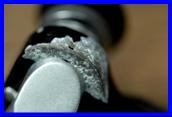


|
These are the corrosion issues: paint loss and bubbling and the type of corrosion common to aluminum and zinc alloys. |

|
Use a brass or bronze brush on a rotary tool to remove the corrosion and bubbling. Brass of bronze will not cut the aluminum the way a steel wheel will. |

|
This is how the binoculars look with removal of the corrosion and bubbling paint: by itself a substantial improvement. |
|
Commonly available modern black lacquer and enamel is too glossy and of the wrong shade to match older binoculars. I use a special lacquer designed for taxidermy for both brush and airbrush, that I really love. It works great, blends & matches well, and dries in 2 or 3 minutes. I get it from Matsuka Taxidermy Supply Co (601 Jet Black). |


|
Paint the cleaned areas, up to the old lacquer without overlapping. Paint several layers, letting dry in between coats, to build the lacquer thickness up to be similar to the original lacquer thickness. |


|
The end result is not undetectable, but it can be acceptable. |


|
Here is another pair of binoculars with typical edge wear. Edge wear of paint is easier to touch up in an inconspicuous manner, than flat surfaces. Before touch up. |

|
After touch up. |
|
A final step is an application of polishing wax, to blend color. |
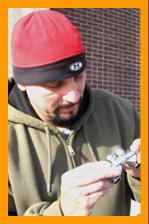



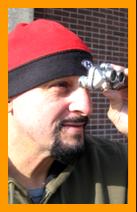
|
ENJOY THE SITE? Consider Participating The website represents the unpaid effort of mostly one person and whenever anybody looks at it, then it actually costs a little bit of money out of pocket. Not a big deal and with a commitment to doing a lot with a little the website is hosted at Nearly Free Speech.net and it is very cost effective. But with as many as 1/4 million page views in busy months, each view does cost a little bit of money and over time it adds up. We really like to encourage active viewer participation: photos, information, feedback, questions, comments, binoculars, anything. Maybe you don’t have any information or photos to contribute, but if you enjoyed this website then please also consider supporting the effort with a tiny gift: 50˘, 75˘, price of a candy bar or cup of coffee...anything. Every 75˘ donated (which goes directly to the web hosting account and can’t be used for anything else) would pay for at least 15,000 (and perhaps a lot more) people to view the website. Many thanks to people who have helped with photos information, feedback, translation improvements, and donations. |
|
To donate a small sum to help host this site paste the following on your browser: https://www.nearlyfreespeech.net/ contribute/miniaturebinoculars.com |


|
Miniature Binoculars with Objective Lens Focus Mechanism: Repairing Stripped Threads on the Inside Objective Barrel |
|
Center focus binoculars that use a lens carrying outer objective barrel telescoping on an inner objective barrel to focus (“objective focus”) seem to have more reliability and parts problems related to alignment, quality, and reliability than ocular focus models (in my opinion). With miniature binoculars, these seem to be mostly economy models made by Tochihara Mico Binoculars Co., and these tend to use a number of failure prone plastic parts as part of the focus mechanism. They also tend to use economical silk screened painted markings rather than rotary engraved markings. The Belfont 6x15 CF binoculars used as an example below were made for catalog showroom retailer W. Bell and Co., and the sidplay problems was that the threads on the plastic inner objective barrel had stripped out or shrunk, making the binoculars non functional. The following improvised repair methodology seemed to work. |


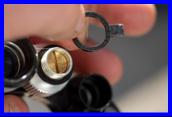
|
Locate and loosen the set screw on the objective side pivot cover and unscrew the cover in a counter clockwise rotation and remove. |
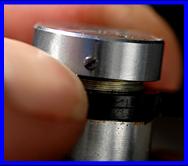


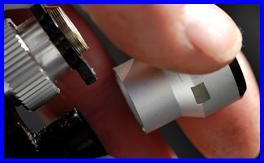
|
Remove one or both of the outer objective tubes. Their ring connections to the elevating mechanism are stacked. Keep the ring with it’s associated objective barrel and note orientation. |
|
Remove the stripped out inner objective barrel (shown in place above but often comes off with the outer objective outer barrel). |

|
The plastic inner objective barrel appears to be polyethylene, a material difficult to get anything to stick to. I used a plastic oriented adhesive and hoped what remained of the threads would help adhesion. |

|
The rings that transfer motion from the focus wheel to the objective barrels must be oriented correctly in order to stack correctly and telescope the 2 barrels equally. |







|
Tochihara Optical Co. made objective focus binoculars (JB 231) with plastic parts that tend to break identified |



|
Tokuhiro Koki Seisakusho made objective focus binoculars (JB 47) with the same vulnerable parts made of metal. |


|
CONTACT US WITH INFORMATION OR COMMENTS: miniature.binoculars@gmail.com |







|
CONTACT US WITH INFORMATION OR COMMENTS: miniature.binoculars@gmail.com |
|
Kikare Reparation, Reparación de Prismaticos, Riparazione del binocolo |
|
Fernglas-Reparatur, Réparation de Jumelles, Ремонт бинокля, 双眼鏡修理 |
|
Miniature Binoculars, Jumelles Miniatures, Miniatur-Ferngläser, ミニチュア双眼鏡, миниатюрные бинокли |
|
FOR OUR MILITARY & FULL SIZE BINOCULARS see sections OTHER BINOCULARS & BIG & SMALL |
![Text Box: CLICK ON PAGE LINE. CLIQUEZ SUR LA LIGNE DE PAGE. KLICKEN SIE AUF SEITENZEILE. HAGA CLIC EN LÍNEA DE PÁGINA..[ページ行]をクリックします。НАЖМИТЕ НА СТРОКУ СТРАНИЦЫ. ALSO SEE INDEX.](image676.gif)